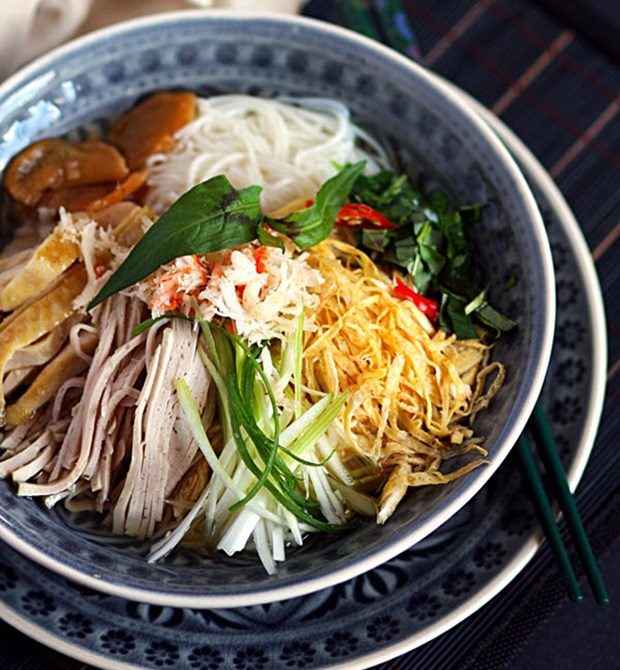Culture
experts are inclined to think that thang
in Han Chinese means ‘broth’, so bún thang can be understood as ‘rice vermicelli in broth’. Indeed, the
core, or the soul, of this dish is the broth which results from simmering
chicken or pig bones with salt water shrimp for hours. Any froth appearing on
the surface has to be removed immediately to avoid turbidity. A standard broth
has to be clear, elegantly sweet, with a touch of shrimp and dry mushroom
flavour and aroma.

Bún thang
There
are about twenty ingredients in a bowl of bún
thang. Fibres of pure white, fine, tangled bún are the bún of
choice. Small domestic chickens are boiled, their meat shredded finely, with a
little shiny skin still attached. Thin pies of lean, pinkish pork paste are cut
into fine threads. Fluffy shrimp pemmican makes it look, smell and taste even
better. Some yellowish, dried threaded turnip marinated with magi is added.
Eggs are mixed with a little vodka to make them thinner, and then fried on as
little oil as possible, and only very briefly to make paper-thin sheets, which
are then cut into fine strips. Thin-top mushroom, green onions and fragrant
knotweed are indispensable, all finely chopped.
All
these ingredients are skilfully arranged in a bowl to make it look like a
flower with a slice of boiled egg as its pistil. As writer Vu Bang described
it, ‘If a bowl of phở (rice noodle)
looks like a colourful oil painting, then a bowl of bún thang depicts a clear and lively river with pencil colours,
which are intermingled but not mixed.
Finally,
the diner may choose to add shrimp paste and belostomatidae attar. As an expert
once remarked, bún thang without
shrimp paste is like sushi without wasabi. And the belostomatidae attar is like
turning the light on at twilight. What a pity that this insect is near
extinction because of pesticides, and the pungent smell and taste is becoming
more and more a nostalgic fairy tale of the Hanoi people.
Bún thang used to be the delicacy of special
occasions, such as New Year or big family events. Nowadays, it is available at
any time. Many shops don’t use all the ingredients prescribed by traditional
recipes. Yet the dish is good enough to make anyone, having tasted it once,
remember it forever.
By Vietnam
Heritage Magazine